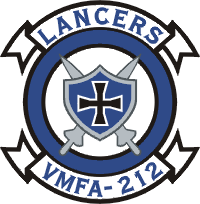
Marine Fighter Attack Squadron 212 (VMFA-212) was a United States Marine Corps F/A-18 Hornet squadron. Most recently known as the "Lancers", the squadron was last based at Marine Corps Air Station Iwakuni, Japan and fell under the command of Marine Aircraft Group 12 (MAG-12) and the 1st Marine Aircraft Wing. VMFA-212 has an extensive combat history having participated in combat operations during World War II, the Korean War, Vietnam War, the Gulf War, and Operation Enduring Freedom. Due to a re-organization within Marine aviation, the squadron was deactivated in 2008.

Marine Attack Squadron 223 (VMA-223) is a United States Marine Corps fixed wing attack squadron that consists of McDonnell-Douglas AV-8B Harrier II (V/STOL) jets. The squadron is based at Marine Corps Air Station Cherry Point, North Carolina and falls under the command of Marine Aircraft Group 14 (MAG-14) and the 2nd Marine Aircraft Wing. The squadron uses "Stone" as its radio callsign.

Marine Fighter Attack Squadron 323 (VMFA-323) is an aircraft carrier-based aviation squadron of the United States Marine Corps. The squadron is equipped with the McDonnell Douglas F/A-18C Hornet and is based at Marine Corps Air Station Miramar, California, United States. It falls under the command of Marine Aircraft Group 11 (MAG-11) and the 3rd Marine Aircraft Wing but deploys with the U.S. Navy's Carrier Air Wing 17 (CVW-17). Their tail code is WS and their radio callsign is Snake.

Marine Fighter Attack Squadron 122 (VMFA-122) is a United States Marine Corps fighter attack squadron flying the F-35B Lightning II. The squadron is based out of Marine Corps Air Station Yuma, AZ and falls under the command of Marine Aircraft Group 13 (MAG-13) and the 3rd Marine Aircraft Wing. The squadron nickname is the "Flying Leathernecks," and their traditional radio call sign is "Nikel". On 14 November 2017, VMFA-122 opened a new chapter of their history, transitioning from the McDonnell Douglas F/A-18C Hornet to the Lockheed Martin F-35B Lightning II and moving from MCAS Beaufort and MAG-31, 2nd MAW to MCAS Yuma and MAG-13, 3rd MAW.
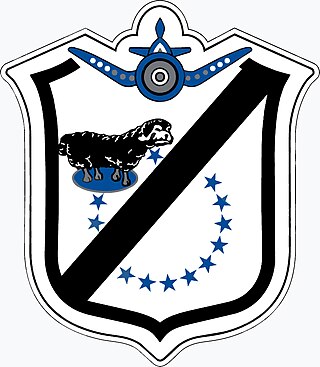
Marine Fighter Attack Squadron 214 (VMFA-214) is a United States Marine Corps fighter attack squadron flying the Lockheed Martin F-35B Lighting II. The squadron's home field is Marine Corps Air Station Yuma, Arizona, and it is assigned to Marine Aircraft Group 13 (MAG-13) of the 3rd Marine Aircraft Wing.

Marine Fighter Attack Squadron 311 (VMFA-311) is a United States Marine Corps fighter attack squadron consisting of F-35C Lightning II. Known as the "Tomcats", the squadron is based at Marine Corps Air Station Miramar, California and falls under the command of Marine Aircraft Group 11 (MAG-11) and the 3rd Marine Aircraft Wing.

Marine Fighter Attack Training Squadron 502 (VMFAT-502) is a United States Marine Corps fighter attack training squadron flying the Lockheed Martin F-35 Lightning II. Known as the "Flying Nightmares", the squadron maintains the history of Marine Attack Squadron 513 (VMA-513) which dates back to World War II and was decommissioned on 12 July 2013. The squadron is based at Marine Corps Air Station Miramar and falls under the command of Marine Aircraft Group 11 and the 3rd Marine Aircraft Wing
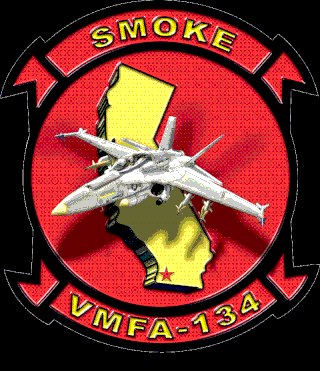
Marine Fighter Attack Squadron 134 (VMFA-134) was a reserve F/A-18 Hornet squadron in the United States Marine Corps. Known as "Smoke", the squadron was based at Marine Corps Air Station Miramar, California and fell under Marine Aircraft Group 46 (MAG-46) and the 4th Marine Aircraft Wing. On 1 April 2007, the squadron was transitioned to cadre status and its gear and personnel were redistributed throughout the remaining F/A-18 Hornet squadrons.

Marine Fighter Attack Squadron 142 (VMFA-142) was an aviation unit of the United States Marine Corps Reserve that was active from 1942 to 2008. At the time of its inactivation, the squadron was based at Naval Air Station Atlanta, Georgia and fell under the command of Marine Aircraft Group 42 (MAG-42), 4th Marine Aircraft Wing. Due to a re-organization within Marine aviation, the squadron moved to Naval Air Station Fort Worth Joint Reserve Base, Texas and was placed in a cadre status under Marine Aircraft Group 41.

Marine Fighter Attack Squadron 542 (VMFA-542) is a United States Marine Corps Aviation fighter attack squadron flying the F-35B Lightning II. VMFA-542 is based at Marine Corps Air Station Cherry Point, North Carolina and falls under the command of Marine Aircraft Group 14 (MAG-14) and the 2nd Marine Aircraft Wing.
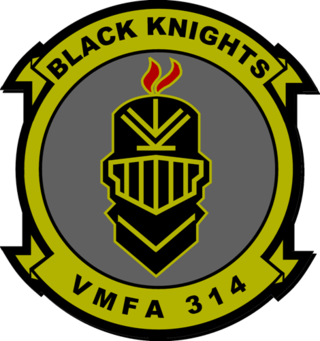
Marine Fighter Attack Squadron 314 (VMFA-314) is a United States Marine Corps F-35C Lightning II squadron. The squadron, known as the "Black Knights", is based at Marine Corps Air Station Miramar, California and falls under the command of Marine Aircraft Group 11 (MAG-11) and the 3rd Marine Aircraft Wing, but deploys with the US Navy's Carrier Air Wing Nine (NG).
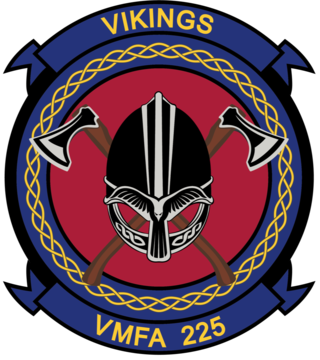
Marine Fighter Attack Squadron 225 (VMFA-225) is a United States Marine Corps fighter attack squadron flying the F-35B Lightning II. The squadron, known as the "Vikings", is based at Marine Corps Air Station Yuma in Arizona and falls under the command of Marine Aircraft Group 13 (MAG-13) and the 3rd Marine Aircraft Wing.

Marine All Weather Fighter Attack Squadron 224 is a United States Marine Corps (USMC) F/A-18 Hornet squadron. Also known as the "Fighting Bengals", the squadron is based at Marine Corps Air Station Beaufort, South Carolina and falls under the command of Marine Aircraft Group 31 (MAG-31) and the 2nd Marine Aircraft Wing. The Bengals are the only Marine F/A-18D Hornet Squadron currently operating out of MCAS Beaufort.
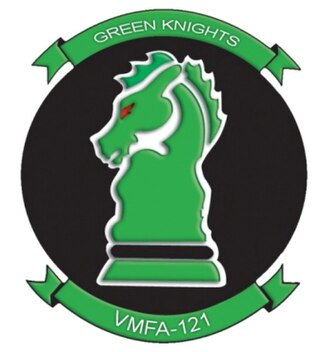
Marine Fighter Attack Squadron 121 (VMFA-121), also known as the "Green Knights", is a United States Marine Corps aircraft squadron operating the F-35B Lightning II. The squadron is based at Marine Corps Air Station Iwakuni, Japan and falls under the command of Marine Aircraft Group 12 (MAG-12) and the 1st Marine Aircraft Wing. Their tail code is VK and their radio call sign is "Combat".

Marine Aircraft Group 13 is a United States Marine Corps aviation unit based at Marine Corps Air Station Yuma that is currently composed of one McDonnell Douglas AV-8B Harrier II squadron, three Lockheed Martin F-35B Lightning II squadrons, an unmanned aerial vehicle squadron, a maintenance and logistics squadron, and a wing support squadron. The group falls under the command of the 3rd Marine Aircraft Wing and the I Marine Expeditionary Force.

Marine Fighter Attack Squadron 242 (VMFA-242) is a United States Marine Corps squadron flying F-35B Lightning II STOVL Stealth Fighter. The squadron, known as the "Bats", is based at Marine Corps Air Station Iwakuni, Japan and falls under the command of Marine Aircraft Group 12 (MAG-12) and the 1st Marine Aircraft Wing. The radio callsign is "Profane".

Marine Fighter Attack Squadron 533 (VMFA-533) is a United States Marine Corps F-35B squadron. Also known as the "Hawks", the squadron is based at Marine Corps Air Station Beaufort, South Carolina and falls under the command of Marine Aircraft Group 31 (MAG-31) and the 2nd Marine Aircraft Wing.

VMFA(AW)-332 Marine All Weather Fighter Attack Squadron 332 was a United States Marine Corps F/A-18 Hornet squadron. Also known as the "Moonlighters", the squadron was based at Marine Corps Air Station Beaufort, South Carolina as part of Marine Aircraft Group 31 (MAG-31), 2nd Marine Aircraft Wing. The squadron flew its last flight in the F/A-18 Hornet on 30 March 2007. At the time of their deactivation, they held the longest streak of mishap-free flight hours for a tactical jet squadron at 109,000 hours.

Marine Fighter Attack Training Squadron 501 (VMFAT-501) is a training squadron in the United States Marine Corps, consisting of 27 F-35B Lightning II aircraft and serves as the Fleet Replacement Squadron. Known as the "Warlords," the squadron is based at Marine Corps Air Station Beaufort, South Carolina and falls administratively under Marine Aircraft Group 31 and the 2nd Marine Aircraft Wing. The squadron has assumed the lineage of VMFA-451 which was originally known as the "Blue Devils" and saw action during World War II and Operation Desert Storm. They were decommissioned on 31 January 1997.

Marine Fighter Attack Squadron 124 (VMFA-124) was a flying squadron in the Marine Forces Reserve based out of Naval Air Station Memphis flying the A-4 Skyhawk. They were part of Marine Aircraft Group 42 and were decommissioned on 19 June 1999. The squadron is best known as the first Marine squadron to fly the F4U Corsair during World War II and also the first squadron to be based on an aircraft carrier. They were known as the "Wild Aces" and ended World War II with 78 air-to-air victories against Japanese aircraft.





























